Orange house exteriors are experiencing a remarkable renaissance in contemporary home design, offering homeowners a chance to create stunning, memorable facades that celebrate warmth, creativity, and architectural distinction. From soft terracotta hues reminiscent of Mediterranean coastlines to bold safety-cone orange statements that command attention, orange exteriors provide endless possibilities for expressing personal style while enhancing curb appeal. Whether embracing traditional Spanish colonial architecture or exploring modern minimalist approaches, orange house exteriors can transform any home into a welcoming, vibrant sanctuary that stands out beautifully in any neighborhood setting.
1. Orange House Exterior with Terracotta Roof Tiles

Combining orange house exteriors with terracotta roof tiles creates an authentic Mediterranean aesthetic that feels both timeless and sophisticated. This classic pairing draws inspiration from Spanish and Italian coastal architecture, where warm orange stucco walls harmonize beautifully with traditional clay tile roofing. The natural variation in terracotta tiles adds texture and depth while complementing the orange walls seamlessly. Consider using a soft peachy-orange shade for the main exterior walls, which allows the rich reddish-brown tones of the roof tiles to stand out as a defining architectural feature. This combination works particularly well with arched windows, wrought iron details, and landscaping featuring native Mediterranean plants like lavender and olive trees.
2. Orange House Exterior with White Trim Color Combination
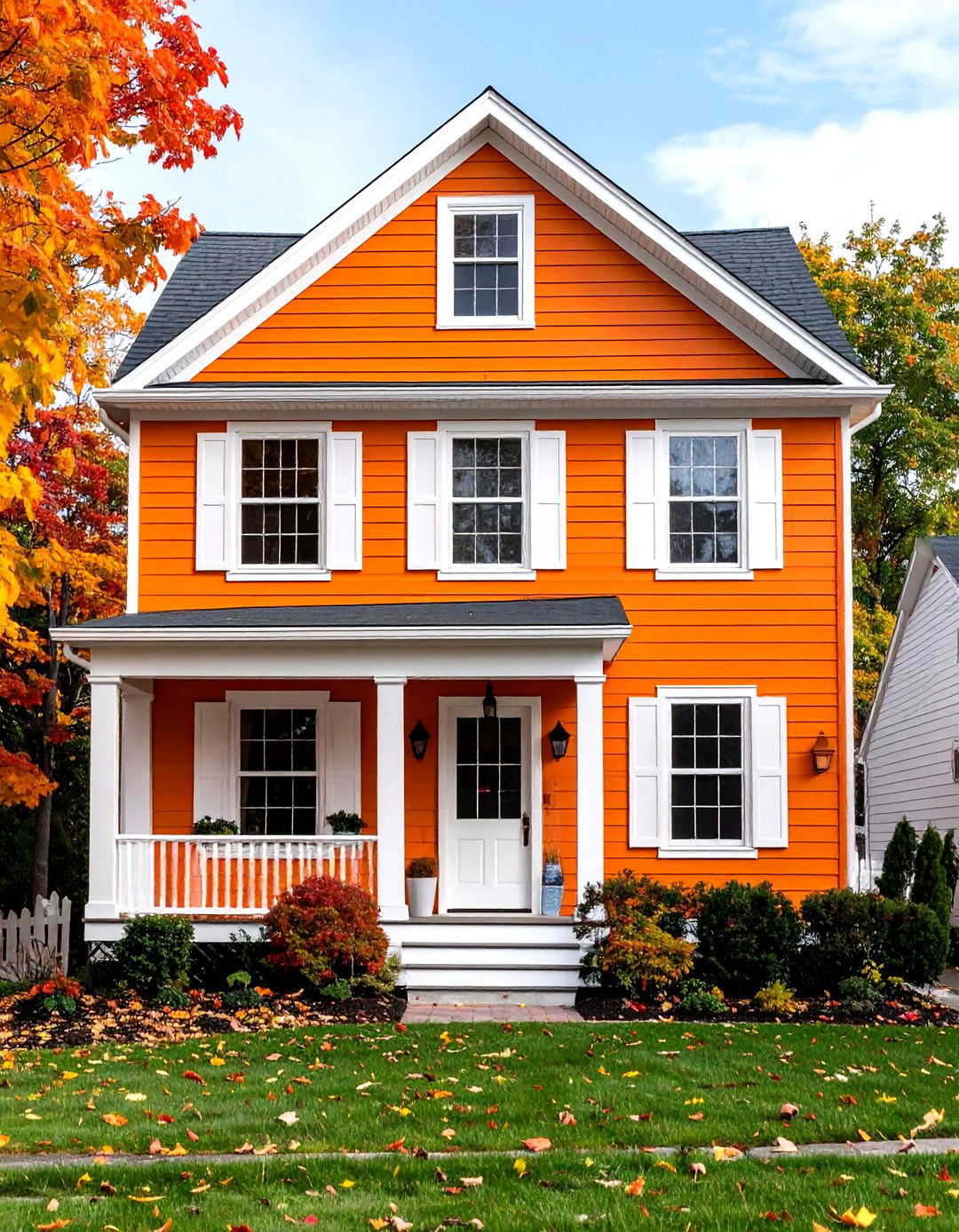
The partnership between orange house exteriors and crisp white trim creates a striking, high-contrast combination that enhances architectural details beautifully. White trim serves as a clean, bright frame that makes orange siding pop while highlighting window frames, fascia boards, and decorative elements. This classic pairing works across various architectural styles, from traditional Colonial homes to contemporary designs. The white trim helps soften bolder orange tones while creating visual interest and definition around key structural elements. For optimal results, choose a warm-toned white like cream or ivory rather than stark white, which can create harsh contrasts. This combination pairs exceptionally well with dark shutters or natural stone accents for added sophistication.
3. Orange House Exterior Mediterranean Stucco Style
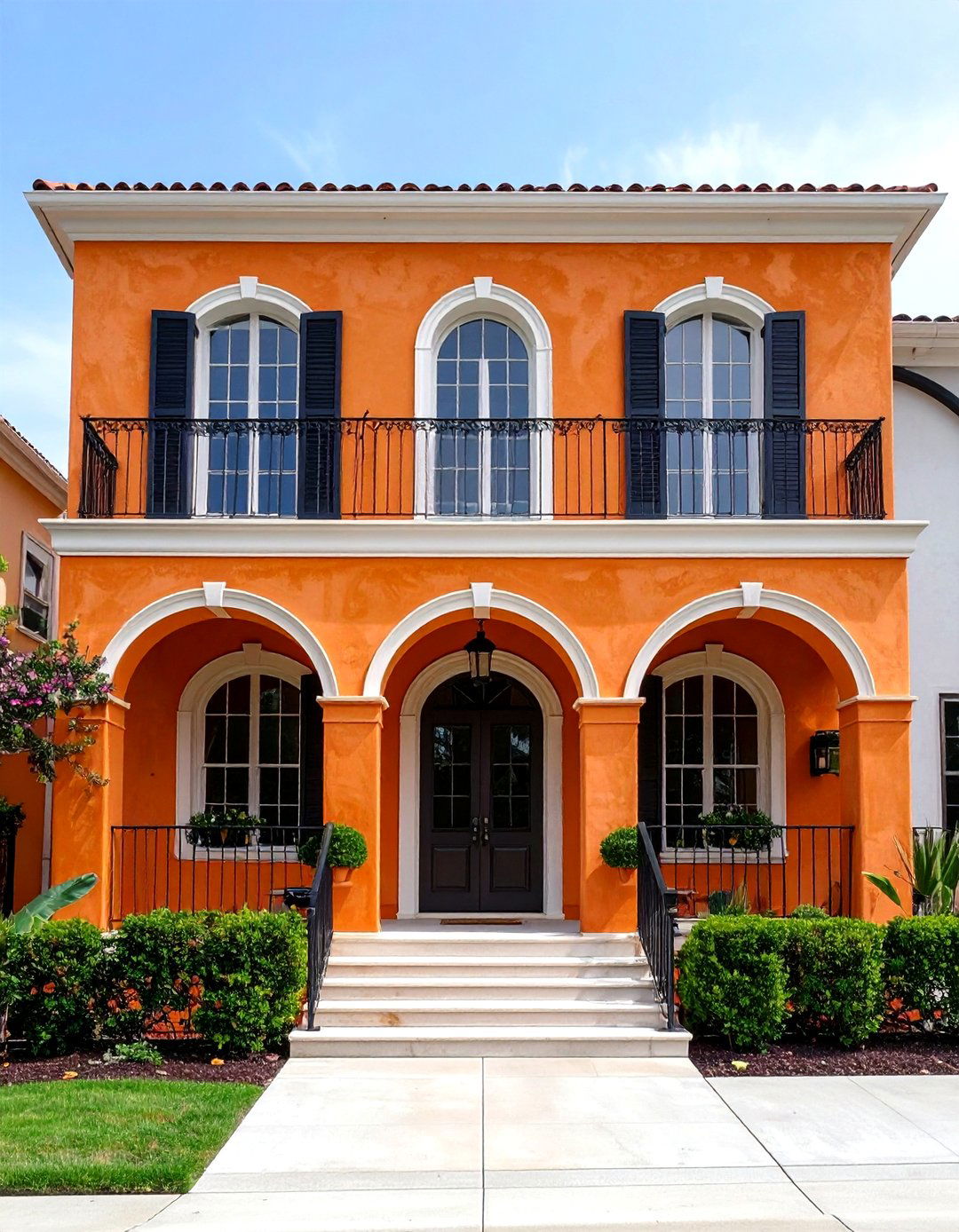
Mediterranean stucco orange house exteriors embody the warmth and elegance of coastal European architecture with their smooth, hand-troweled surfaces and rich coloration. Stucco provides the perfect canvas for orange tones, offering texture variation that creates visual depth while reflecting light beautifully throughout the day. Choose warm, earthy orange shades that mimic the natural clay and limestone found in Mediterranean regions. This style traditionally features arched doorways, decorative tile work, and wrought iron accents that complement the orange stucco beautifully. The material's durability makes it ideal for various climates while requiring minimal maintenance. Consider adding architectural details like decorative brackets, carved stone elements, or ceramic tile borders to enhance the authentic Mediterranean character of your orange stucco exterior.
4. Orange House Exterior Craftsman Bungalow Design
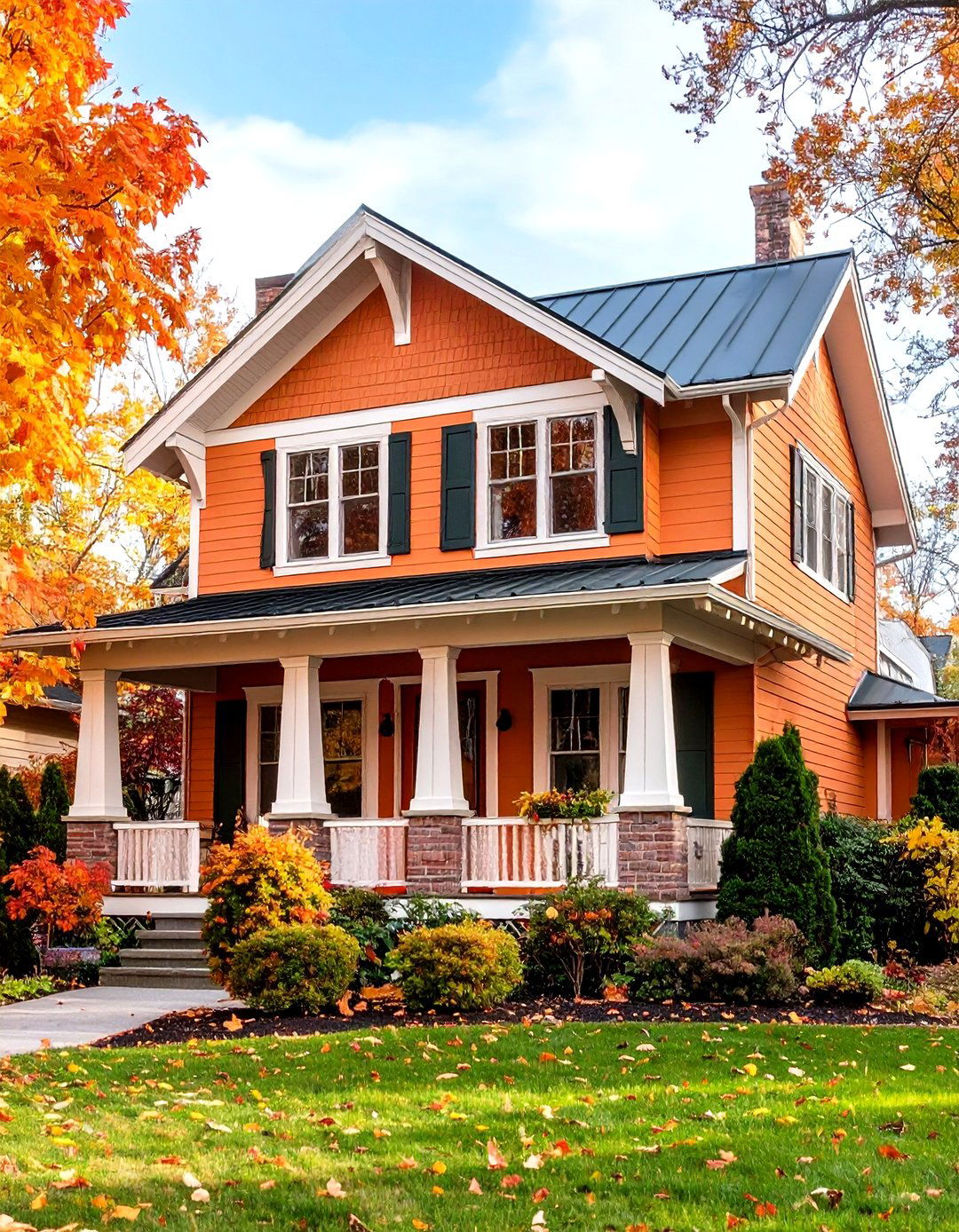
Orange house exteriors on Craftsman bungalows create a warm, inviting aesthetic that celebrates the Arts and Crafts movement's emphasis on natural materials and colors. Craftsman-style homes dressed in peachy orange tones with traditional dark green metal roofs and white trim showcase how this architectural style embraces nature-inspired color palettes. The orange exterior beautifully complements the style's characteristic features like exposed rafter tails, tapered porch columns, and mixed materials. Consider using a muted orange shade that allows natural wood elements and stone foundations to shine. This approach works particularly well when paired with deep green shutters, bronze hardware, and native landscaping. The orange color enhances the home's welcoming character while maintaining the Craftsman tradition of harmony with the natural environment.
5. Orange House Exterior with Burnt Orange Accent Features

Incorporating burnt orange accents into your house exterior design creates a sophisticated, layered color scheme that adds warmth without overwhelming the overall aesthetic. Burnt orange serves as an excellent accent color for doors, shutters, trim details, and architectural elements while complementing neutral base colors beautifully. This approach allows homeowners to embrace orange tones while maintaining broader appeal and versatility. Use burnt orange on front doors to create stunning focal points, or apply it to window shutters for subtle warmth. The color pairs exceptionally well with sage green, cream, charcoal gray, and natural stone materials. This strategy provides flexibility for future updates while creating immediate visual impact through strategic color placement that highlights your home's best architectural features.
6. Orange House Exterior Modern Contemporary Approach
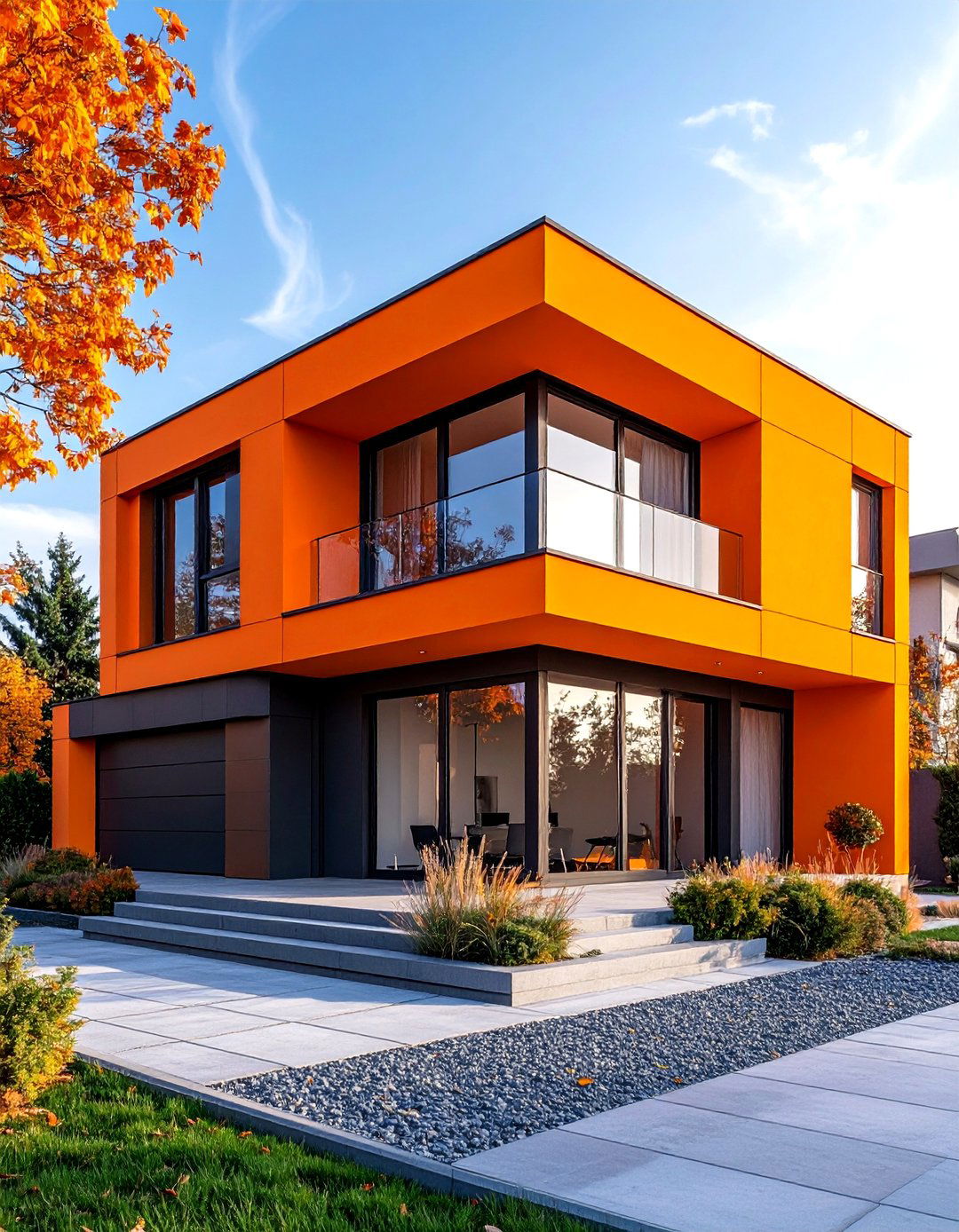
Modern contemporary orange house exteriors challenge traditional color conventions with bold, clean applications that emphasize geometric forms and minimalist aesthetics. Contemporary designs can successfully incorporate vibrant orange shades, even "Safety Cone Orange," when applied thoughtfully to create striking architectural statements. These designs often feature smooth surfaces, large windows, and simple rooflines that showcase the orange color as the primary design element. Consider pairing bright orange with neutral materials like steel, concrete, or natural wood to create sophisticated contrasts. The key lies in confident application and strategic use of complementary materials that ground the bold color choice. Modern orange exteriors work particularly well in urban settings where architectural experimentation is celebrated and embraced.
7. Orange House Exterior Spanish Colonial Revival Style

Spanish Colonial Revival orange house exteriors capture the romantic elegance of early California architecture with their warm, inviting color palettes and distinctive architectural details. This style traditionally features stucco walls in warm orange and terra cotta tones, complemented by red tile roofs and ornate ironwork details. The orange exterior serves as a perfect backdrop for characteristic features like arched windows, decorative tile work, and elaborate entrance portals. Consider using gradient orange tones that vary from light peach to deeper terra cotta to create visual interest and architectural depth. This style naturally incorporates outdoor living spaces like courtyards and covered patios that extend the orange color scheme into landscaped areas. The result is a cohesive design that celebrates indoor-outdoor living while honoring historical architectural traditions.
8. Orange House Exterior with Green Shutters Contrast
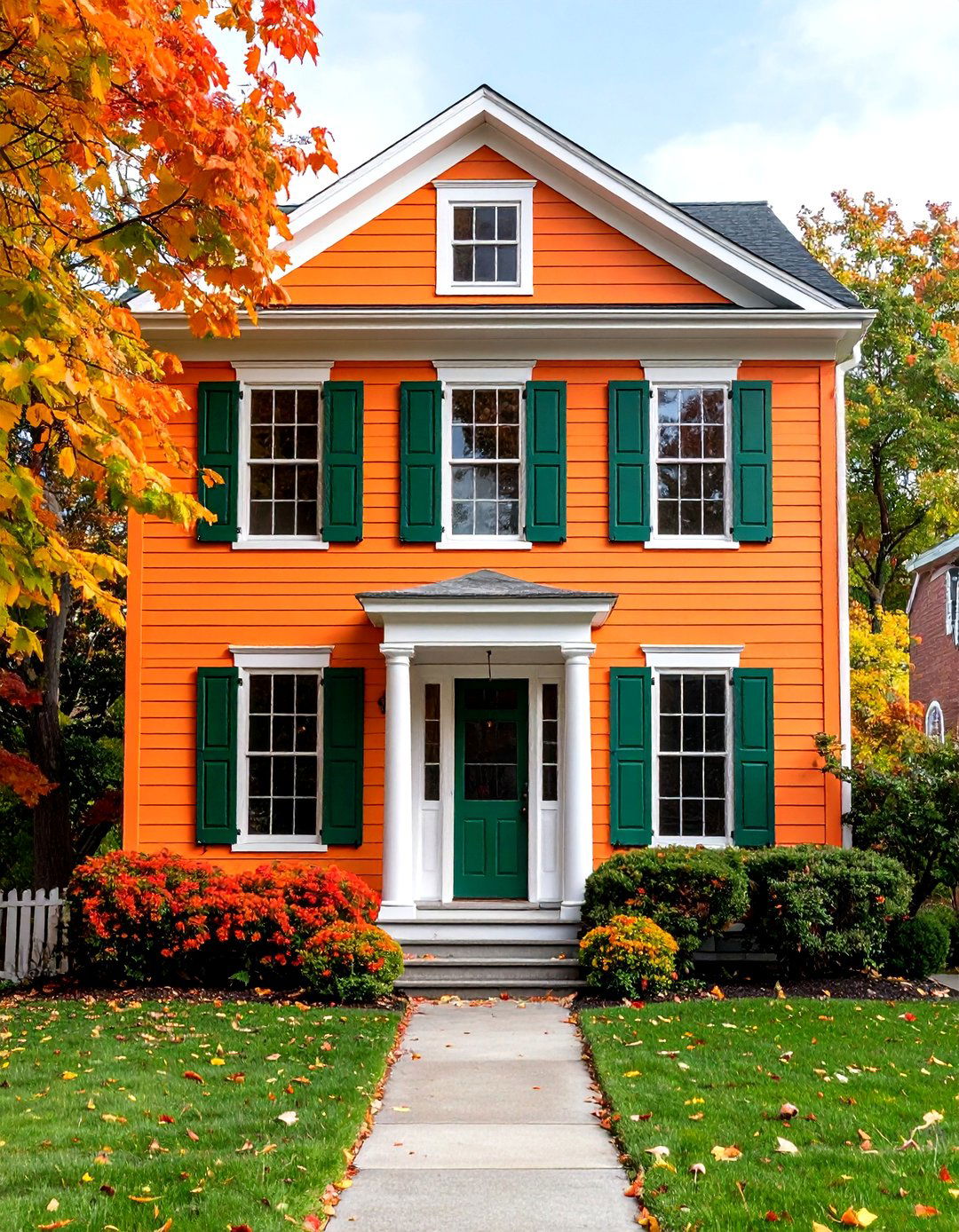
Orange house exteriors paired with green shutters create a complementary color relationship that feels both natural and sophisticated, drawing inspiration from autumn landscapes and traditional European color schemes. Cool shades of gray and green help balance warm-toned brick or orange exteriors, creating subtly colorful palettes that enhance architectural details. This combination works particularly well because orange and green are neighbors on the color wheel, creating harmony while providing sufficient contrast for visual interest. Consider deep forest green or sage green shutters that complement different orange tones from light peach to deeper burnt orange. The green elements can extend to other exterior features like front doors, window boxes, or architectural trim. This classic pairing enhances curb appeal while maintaining timeless elegance that ages gracefully.
9. Orange House Exterior Adobe Southwestern Design
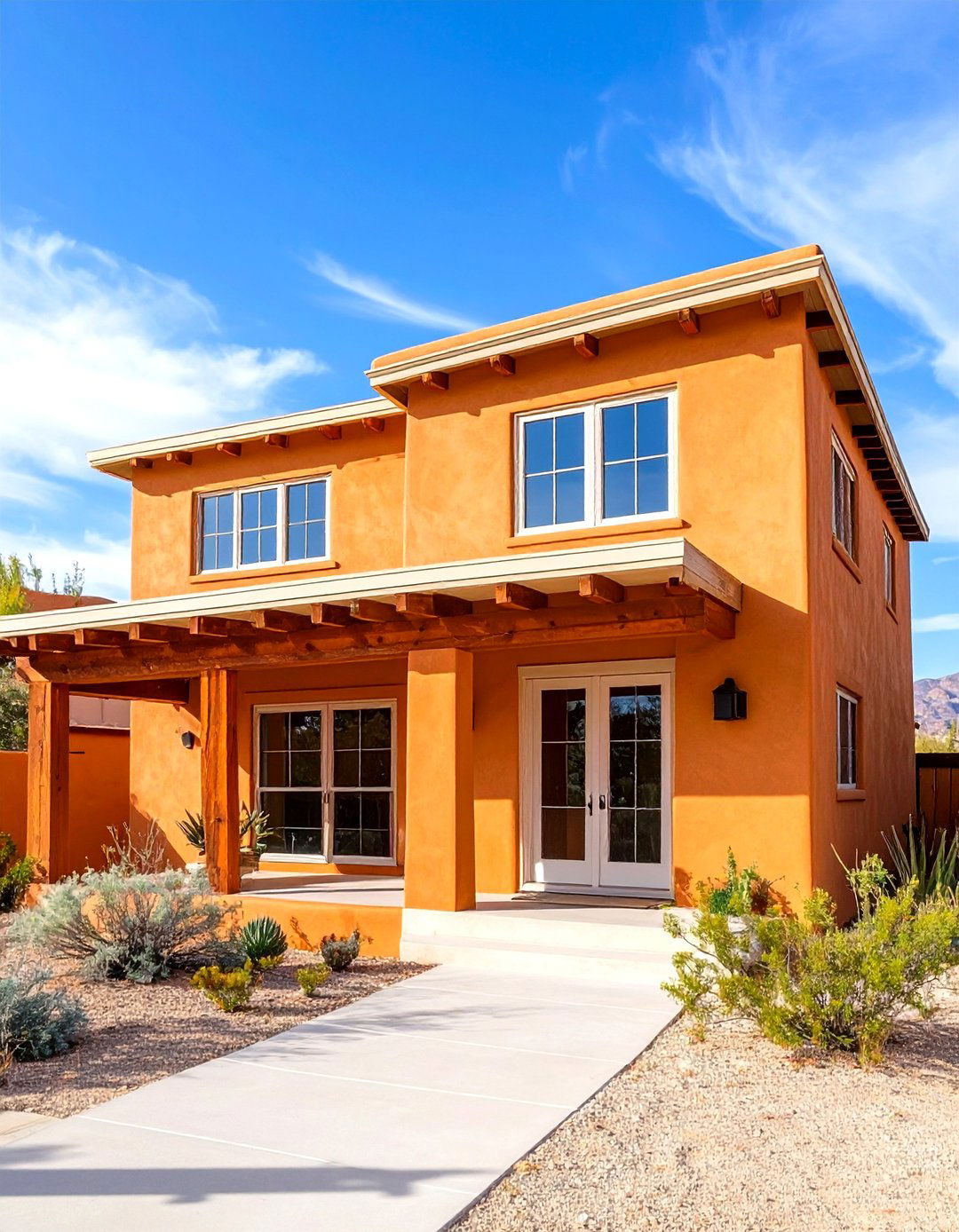
Adobe-style orange house exteriors embody the authentic spirit of Southwestern architecture with their earth-toned color palettes and organic, hand-crafted appearance. Adobe-style homes in the Southwest naturally embrace ochre, brown, dusty rose, and muted orange color schemes that reflect the regional desert landscape. These designs feature thick walls, small windows, and flat or low-pitched roofs that create distinctive silhouettes against desert skies. The orange exterior color should reflect natural clay and earth pigments found in the local landscape, creating harmony with the surrounding environment. Consider incorporating traditional Southwestern elements like vigas (exposed wooden beams), latillas (wooden ceiling slats), and decorative tile work. The result is an authentic regional design that celebrates local building traditions while providing energy-efficient living suited to desert climates.
10. Orange House Exterior Tuscan Inspired Style

Tuscan-inspired orange house exteriors evoke the rustic elegance of Italian countryside villas with their warm, weathered color palettes and romantic architectural details. Large Tuscan orange two-story stucco houses with hip roofs and tile roofing create authentic Mediterranean aesthetics that transport homeowners to European landscapes. This style embraces imperfection and patina, using orange tones that appear naturally aged and weathered by time. The exterior should feature varied orange hues that create depth and visual interest through subtle color variations. Complement the orange walls with natural stone accents, wrought iron details, and cypress trees that enhance the Italian countryside aesthetic. Consider adding architectural elements like decorative brackets, arched openings, and terracotta planters that reinforce the Tuscan character while creating inviting outdoor living spaces.
11. Orange House Exterior with Dark Roof Combinations

Orange house exteriors paired with dark roofing materials create dramatic, sophisticated color schemes that enhance architectural presence and visual impact. Dark green metal roofs, charcoal gray shingles, and black roofing materials provide striking contrasts that make orange exteriors appear more vibrant and well-grounded. This combination works across various architectural styles, from traditional to contemporary designs. The dark roof serves as a strong visual anchor that prevents orange walls from appearing too bright or overwhelming. Consider materials like standing seam metal roofing in dark bronze, slate-colored composite shingles, or clay tiles in deep brown tones. The contrast creates definition between roof and wall surfaces while emphasizing the home's architectural form. This approach provides excellent curb appeal while ensuring the orange exterior appears intentional and well-designed.
12. Orange House Exterior Peach-Orange Soft Tone Variation
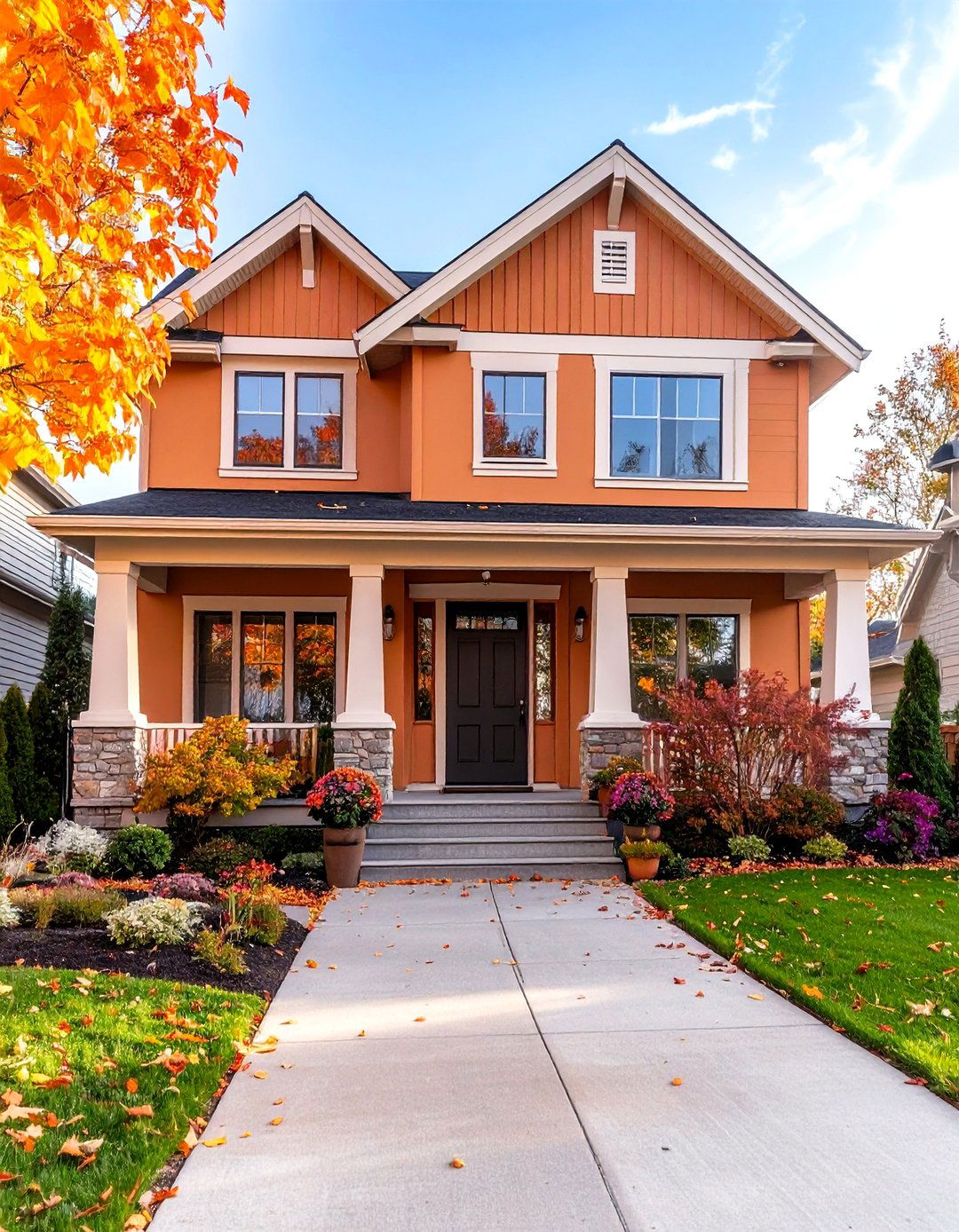
Peach-orange house exteriors offer a gentler approach to orange color schemes, providing warmth and personality without the boldness of more saturated orange tones. Soft orange tones like Sherwin-Williams Subdued Sienna bring warmth and charm to exteriors while maintaining sophisticated, approachable aesthetics. These softer variations work particularly well on traditional home styles where subtlety is preferred over dramatic statements. Peach-orange exteriors pair beautifully with cream trim, natural stone accents, and landscape elements that emphasize the color's connection to nature. This approach allows homeowners to embrace orange tones while maintaining broad appeal for resale value. The color works exceptionally well in natural lighting conditions, appearing warm and inviting throughout different times of day while complementing surrounding landscape elements and neighboring homes.
13. Orange House Exterior with Stone Accent Materials
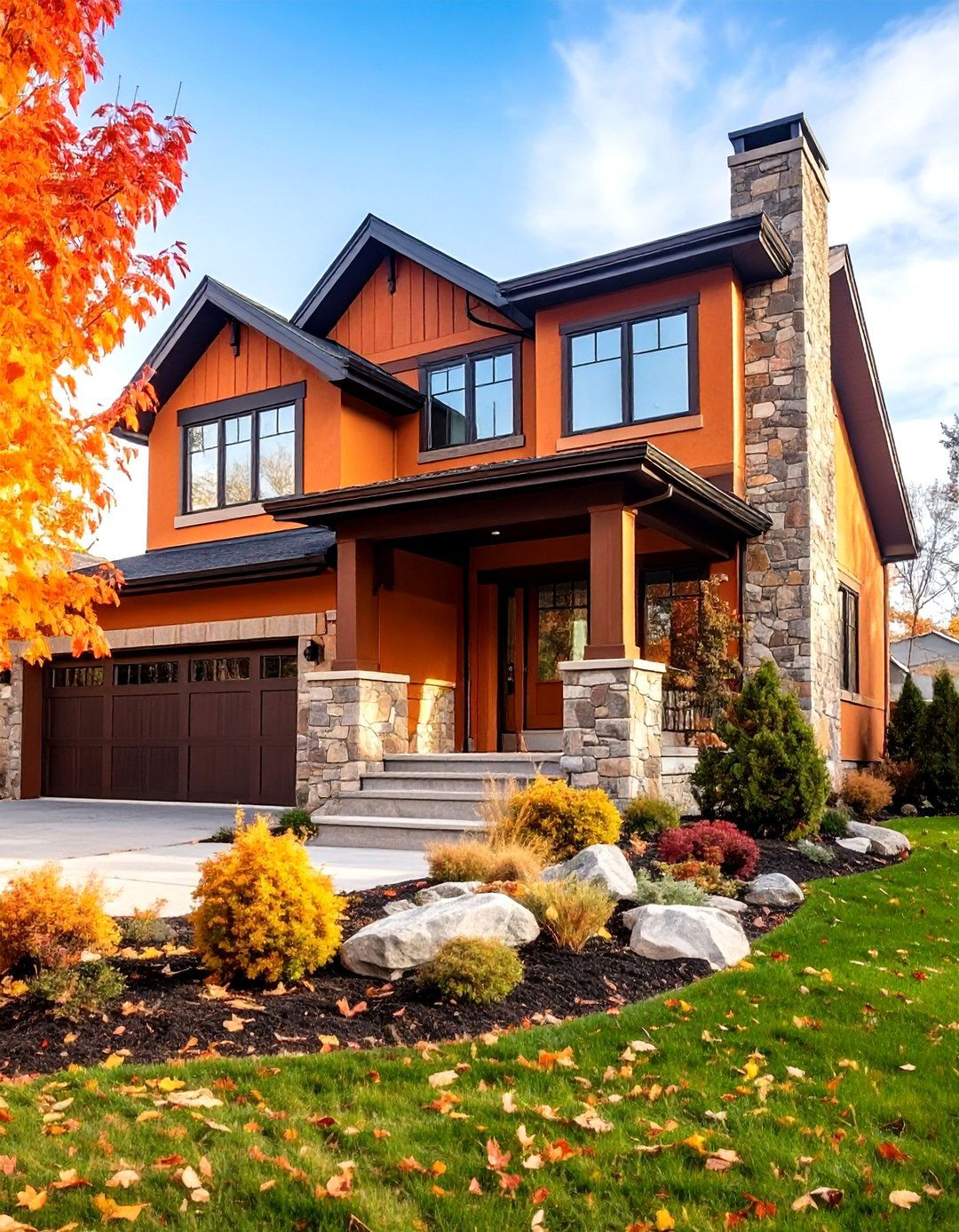
Combining orange house exteriors with natural stone accents creates sophisticated, textural contrasts that enhance both materials while grounding bold color choices with natural elements. Stone chimneys, foundations, and accent walls provide neutral, earthy complements that make orange exteriors appear more refined and architecturally substantial. This combination works particularly well because stone's natural color variations include warm tones that harmonize with orange hues. Consider using fieldstone, limestone, or sandstone that contains warm undertones complementary to your chosen orange shade. The stone elements can extend to landscape features like retaining walls, pathways, and outdoor fireplace surrounds that create cohesive outdoor living spaces. This approach adds significant visual weight and permanence to the design while creating sophisticated material combinations that enhance property value.
14. Orange House Exterior Victorian Era Color Application

Victorian-era orange house exteriors celebrate the period's embrace of bold, expressive color schemes while highlighting ornate architectural details and decorative elements. Victorian facades can support multiple colors including orange tones that enhance period details without overwhelming the ornate architectural features. This approach requires careful consideration of trim colors, accent details, and architectural elements that define Victorian character. Use orange as either a primary color or accent shade that complements the home's elaborate millwork, bay windows, and decorative brackets. Consider incorporating multiple complementary colors that were popular during the Victorian era, such as deep greens, burgundy, and cream tones. The key lies in using orange to enhance rather than compete with the home's architectural ornamentation while maintaining historical authenticity and period-appropriate color relationships.
15. Orange House Exterior with Metal Roof Pairings
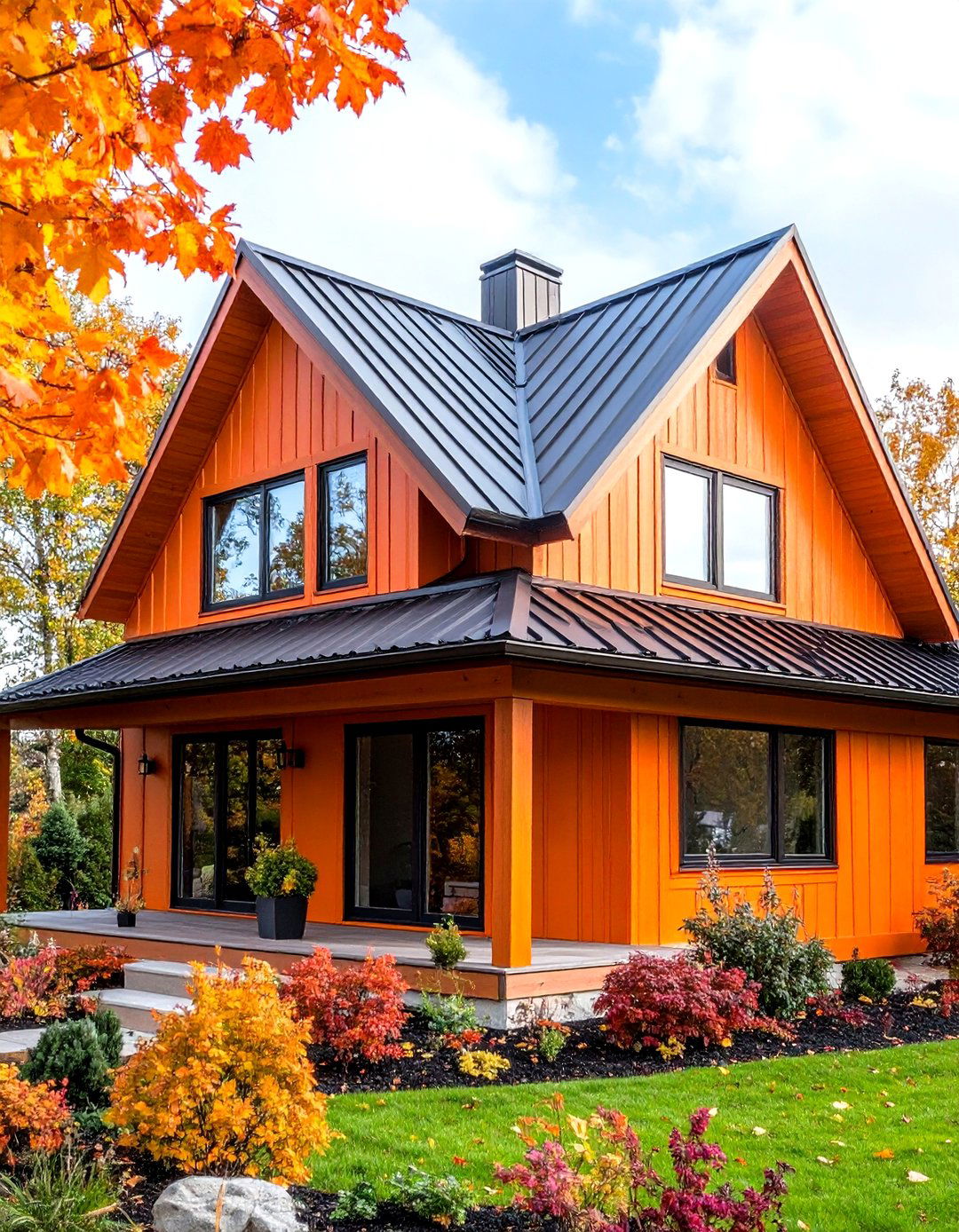
Orange house exteriors combined with metal roofing create contemporary, energy-efficient designs that offer excellent durability while showcasing bold color combinations. Metal roofs in materials like Rheinzink reflect heat effectively while providing sleek, modern aesthetics that complement orange exterior walls. This combination works particularly well on contemporary and industrial-style homes where clean lines and modern materials are emphasized. Consider standing seam metal roofing in bronze, charcoal gray, or weathered steel finishes that provide subtle contrasts without competing with the orange walls. The metal's reflective properties help reduce cooling costs while creating sophisticated visual textures. This pairing works especially well in regions with intense sun exposure where energy efficiency and durability are primary concerns while maintaining striking architectural aesthetics.
16. Orange House Exterior Coastal Mediterranean Approach

Coastal Mediterranean orange house exteriors capture the relaxed elegance of seaside architecture while embracing the warm, sun-soaked color palettes characteristic of coastal living. Mediterranean coastal designs often feature orange and terra cotta tones that blend seamlessly with ocean views and beachside landscapes. This approach emphasizes indoor-outdoor living with large windows, covered terraces, and outdoor entertaining spaces that extend the orange color scheme into landscape design. Choose orange tones that reflect natural elements like coral, sea glass, and sunset colors found in coastal environments. The design should incorporate materials like weathered wood, natural stone, and tile that can withstand coastal conditions while maintaining aesthetic appeal. Consider adding architectural elements like pergolas, outdoor kitchens, and water features that enhance the coastal Mediterranean lifestyle while complementing the orange exterior color scheme.
17. Orange House Exterior with Natural Wood Element Integration
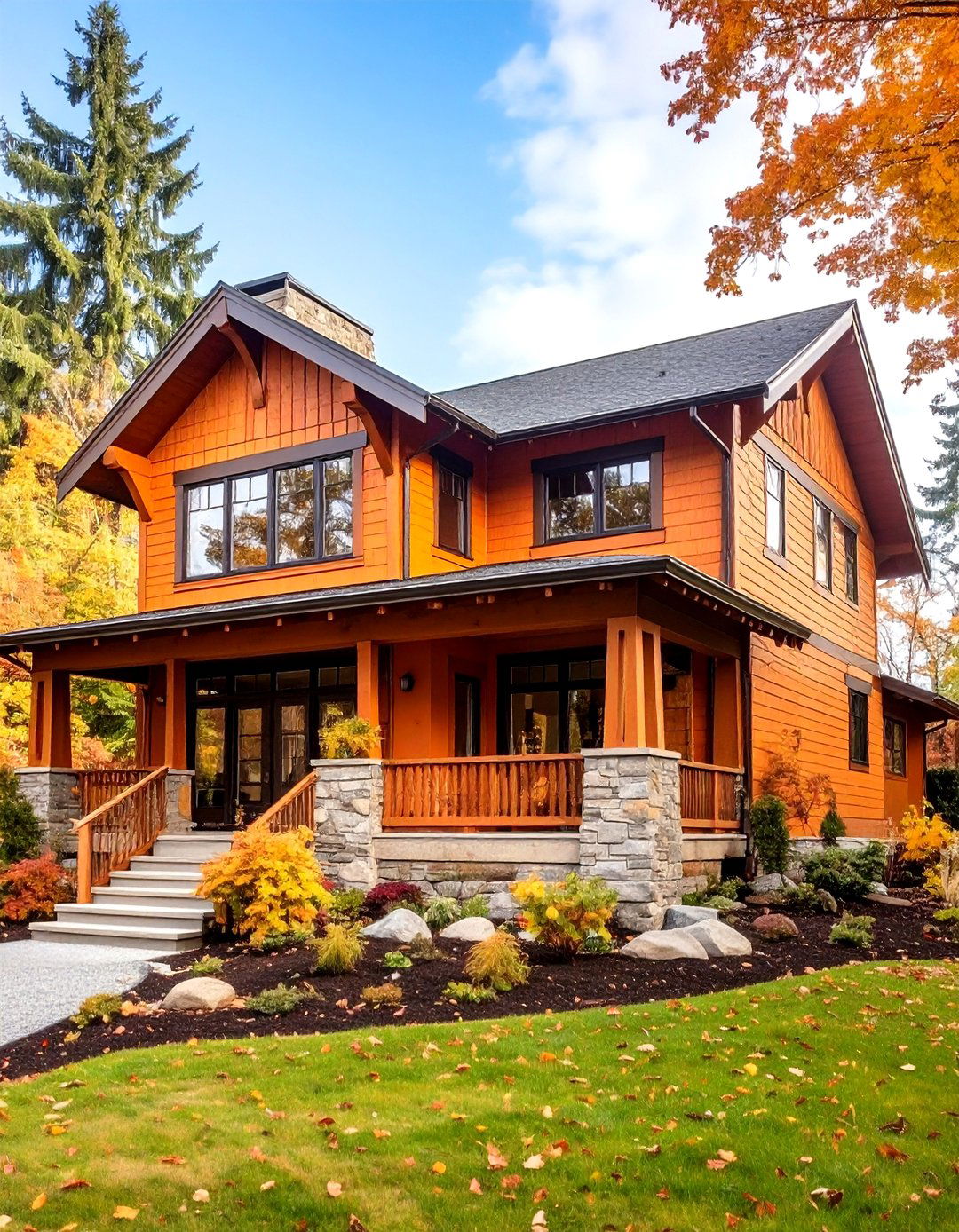
Integrating natural wood elements with orange house exteriors creates warm, organic color combinations that celebrate natural materials while adding textural richness and visual depth. Cedar siding, exposed beams, and natural wood trim provide beautiful contrasts that ground orange exteriors while adding architectural authenticity. This approach works particularly well on Craftsman, rustic, and contemporary homes where natural materials are emphasized. Consider using weathered cedar, redwood, or teak that develops natural patina over time, complementing orange tones beautifully. The wood elements can include siding accents, pergolas, shutters, and entry doors that create sophisticated material combinations. This strategy provides visual warmth while connecting the home to its natural surroundings through material choices that age gracefully and require minimal maintenance while enhancing the orange exterior's natural appeal.
18. Orange House Exterior Desert Landscape Color Scheme
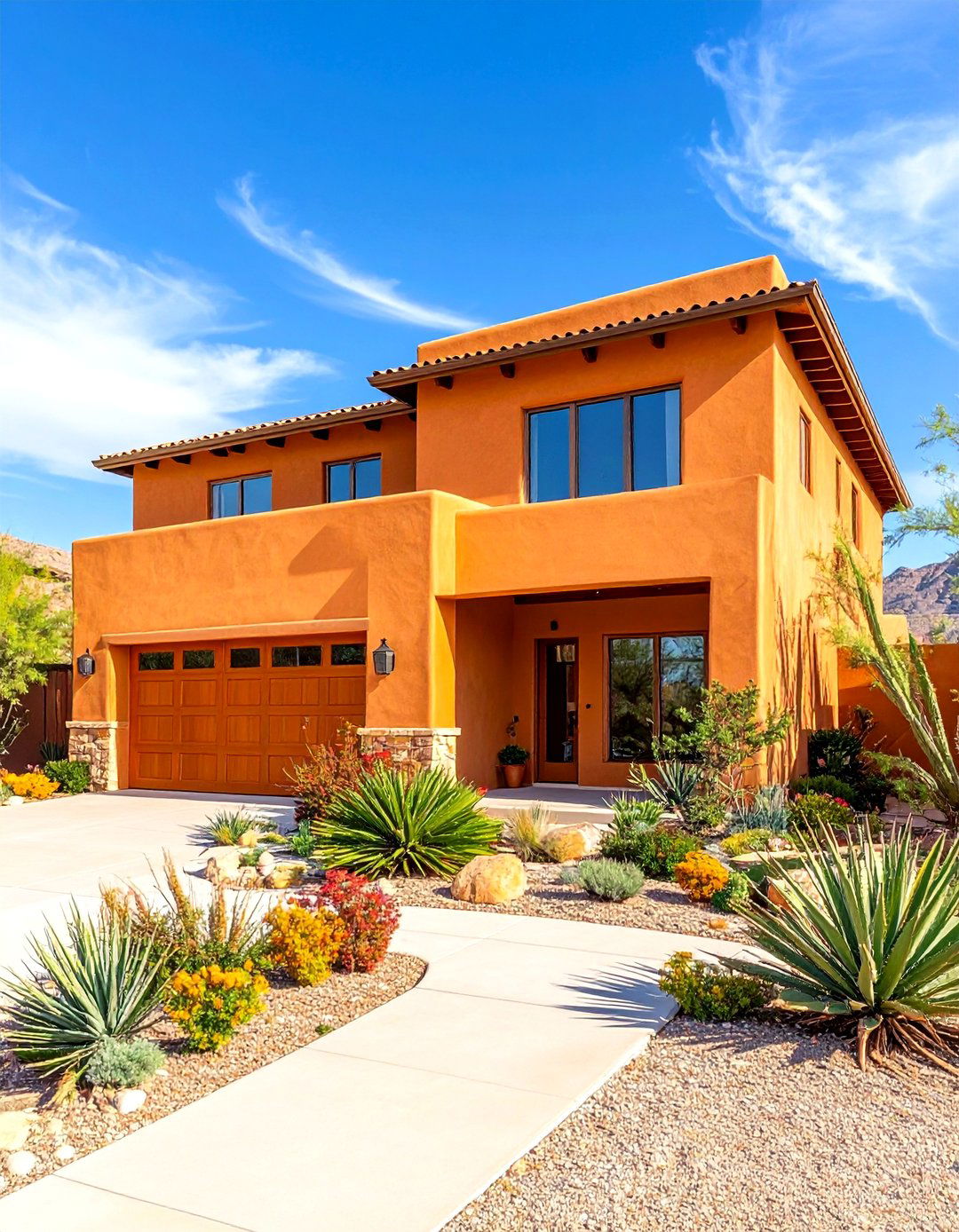
Desert landscape orange house exteriors embrace the natural color palette of arid environments, creating harmonious relationships between architecture and surrounding landscape. Desert-inspired orange color schemes incorporate ochre, burnt orange, and sienna tones that reflect natural clay formations and desert sunset colors. This approach emphasizes water-wise landscaping with native plants like succulents, cacti, and drought-tolerant perennials that complement orange exterior colors naturally. The design should incorporate sustainable building practices and materials that perform well in desert climates while maintaining aesthetic appeal. Consider using stucco finishes, natural stone accents, and metal roofing that reflect heat while creating sophisticated architectural details. The result is an environmentally conscious design that celebrates regional character while providing comfortable, energy-efficient living spaces that blend seamlessly with desert landscapes.
19. Orange House Exterior Traditional Cottage Style Adaptation

Traditional cottage orange house exteriors offer charming, approachable aesthetics that transform classic cottage architecture with warm, inviting color schemes that enhance quaint architectural details. Cottage-style homes can successfully incorporate orange tones that complement the style's emphasis on comfort, charm, and connection to garden landscapes. This approach emphasizes smaller-scale details like window boxes, picket fences, and cottage gardens that integrate orange exterior colors with landscape design. Choose soft, muted orange tones that maintain the cottage style's intimate, welcoming character while providing sufficient color interest. The design should incorporate traditional cottage elements like diamond-pane windows, decorative brackets, and climbing vines that enhance the home's storybook appeal. This strategy creates engaging curb appeal while maintaining the cottage tradition of harmony between architecture and garden design.
20. Orange House Exterior Bold Safety Cone Orange Statement Design
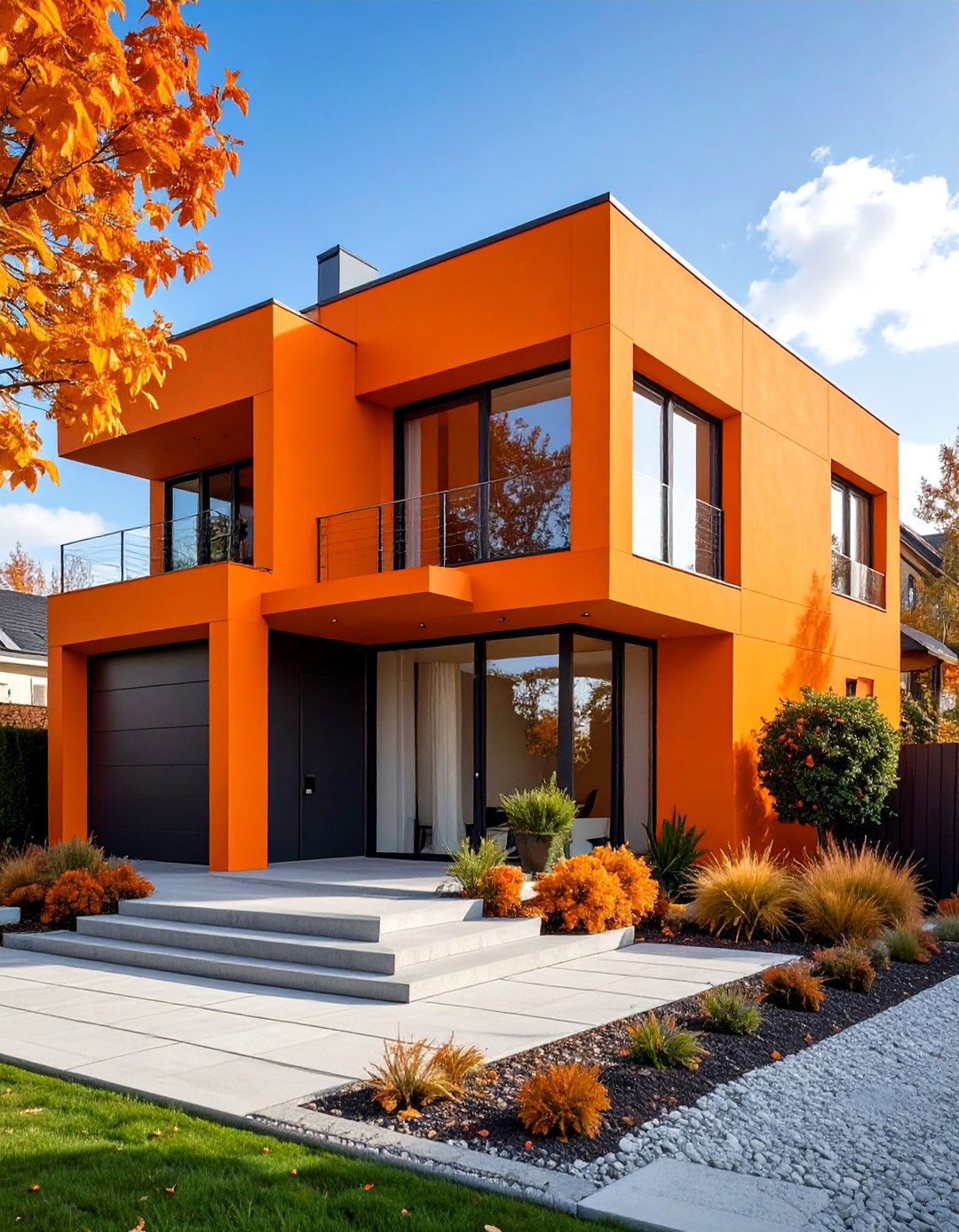
Bold safety cone orange house exteriors represent fearless design choices that create unforgettable architectural statements while challenging conventional color expectations. Safety Cone Orange by Fine Paints of Europe demonstrates how confident homeowners can successfully incorporate vibrant orange tones typically reserved for traffic signage into sophisticated residential designs. This approach requires careful consideration of complementary materials and landscape design that support rather than compete with the bold color choice. Consider pairing the vibrant orange with neutral materials like concrete, steel, or natural wood that provide visual relief while emphasizing the color's impact. The key lies in confident application and high-quality execution that transforms a potentially risky color choice into a sophisticated design statement. This strategy works particularly well for homeowners seeking unique, memorable exteriors that reflect creative personalities while maintaining architectural integrity.
Conclusion:
Orange house exteriors offer remarkable versatility for creating distinctive, memorable homes that celebrate warmth, creativity, and architectural character. From subtle peach tones to bold statement colors, orange provides endless opportunities for personal expression while enhancing curb appeal across various architectural styles. Whether embracing traditional Mediterranean aesthetics or exploring contemporary design approaches, orange exteriors can transform any home into a welcoming, vibrant sanctuary that stands beautifully in any neighborhood setting while reflecting the homeowner's unique personality and style preferences.


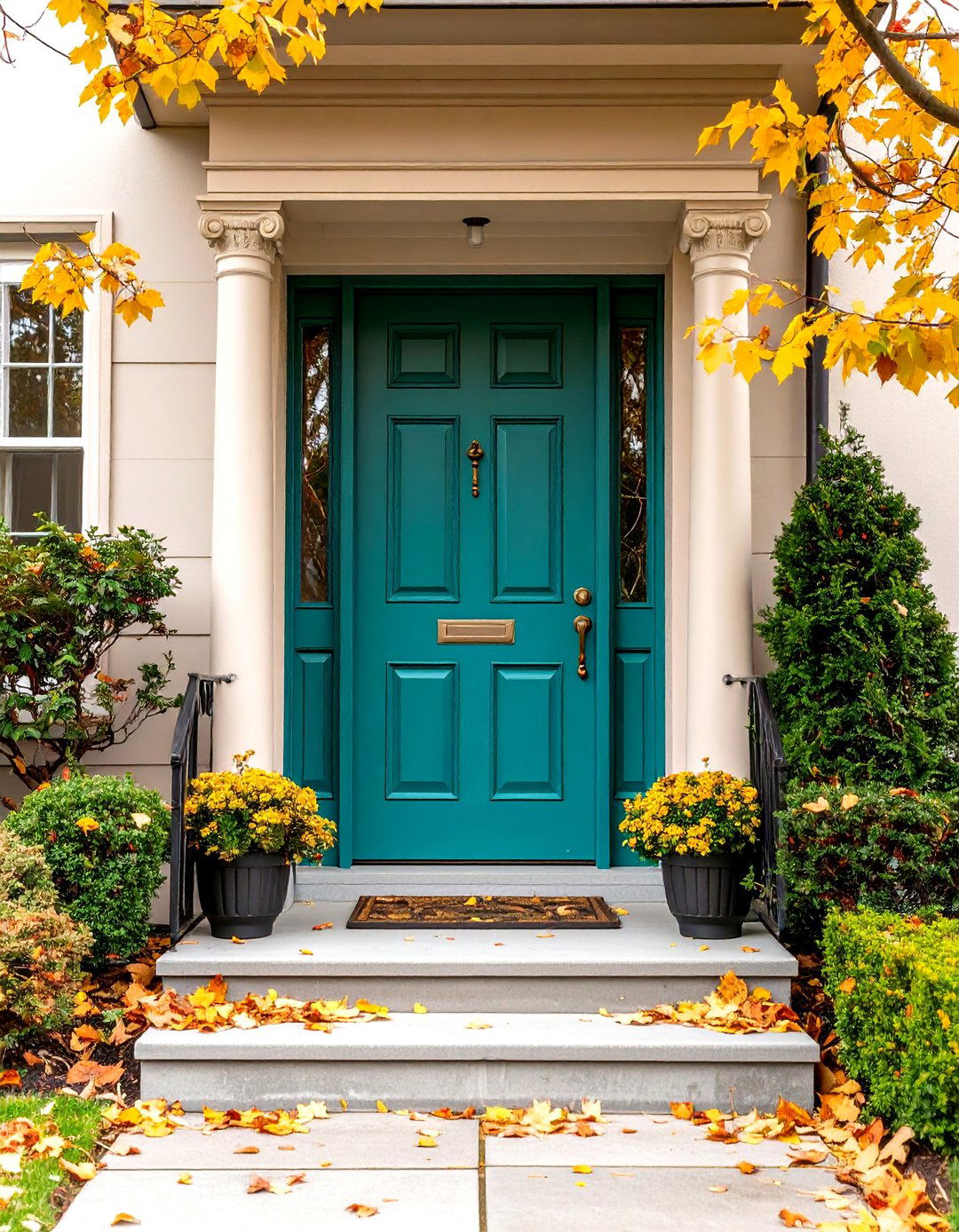
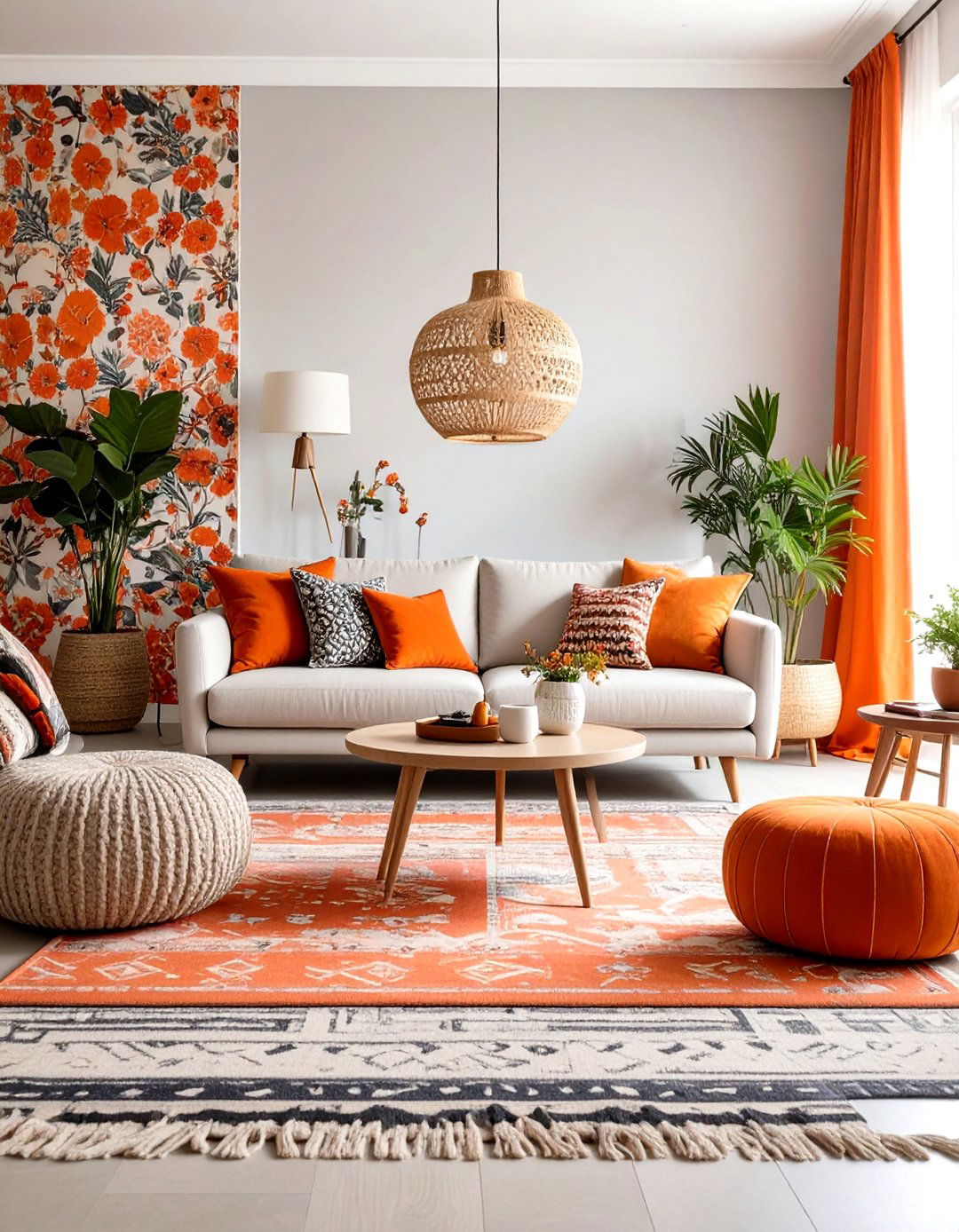
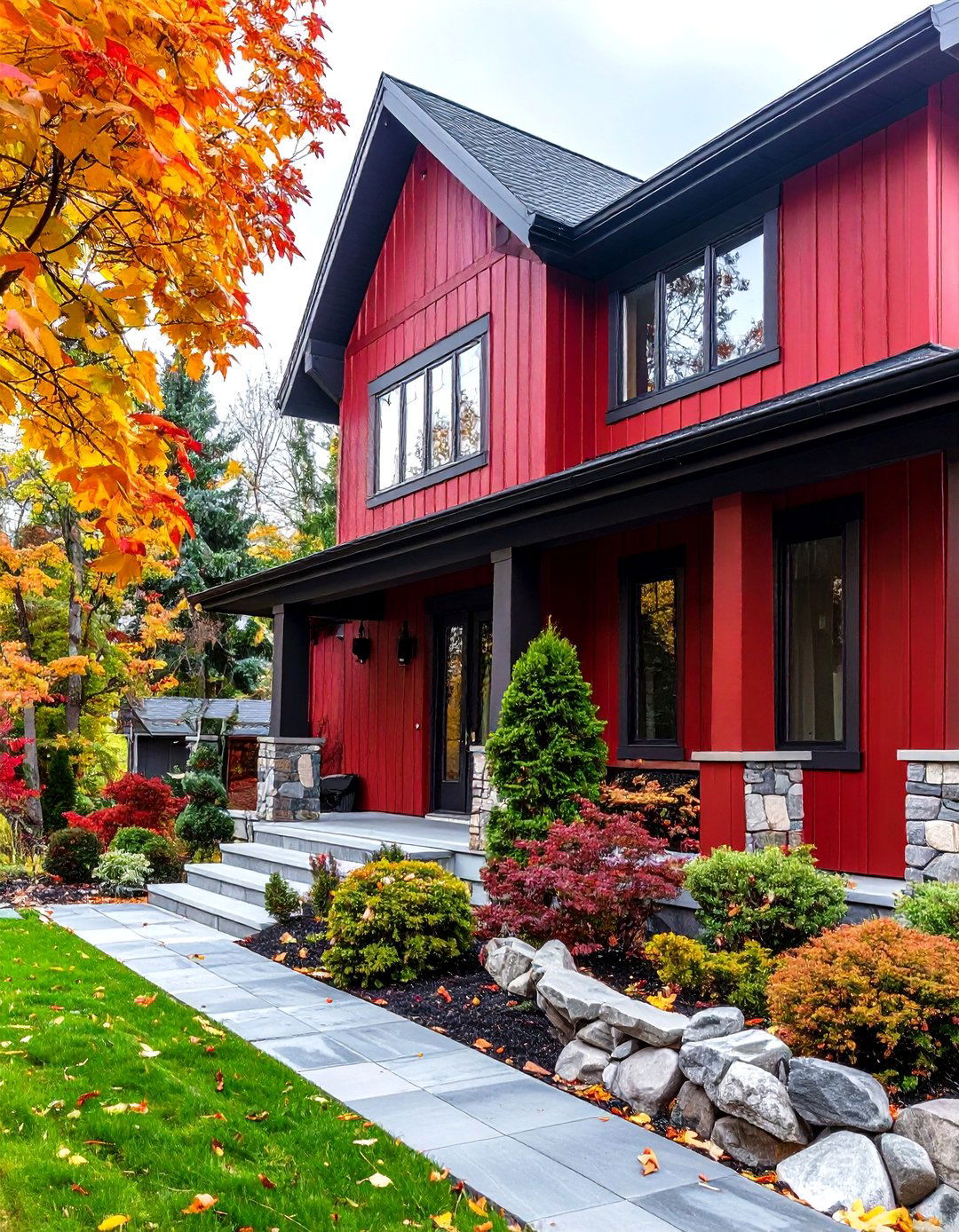
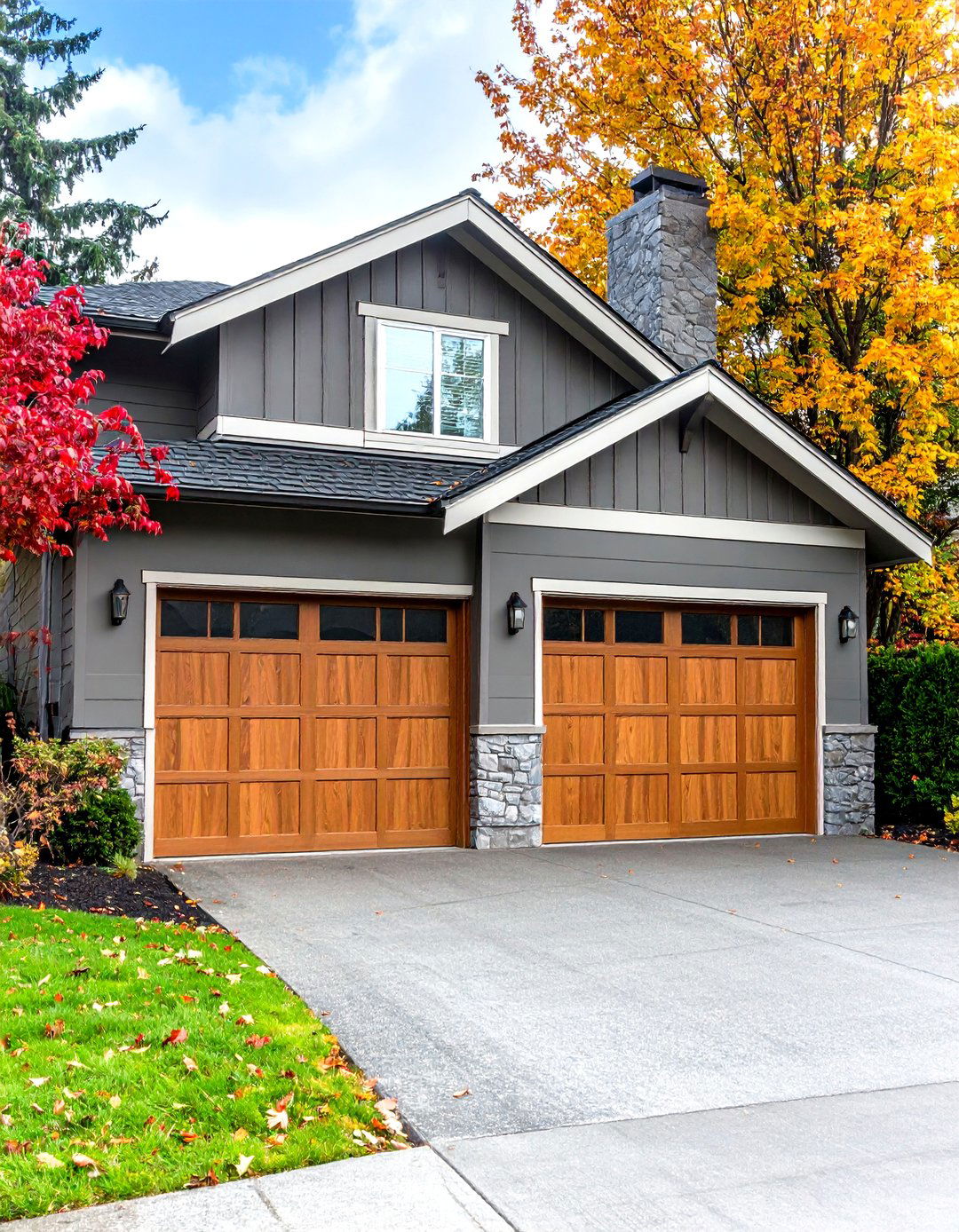


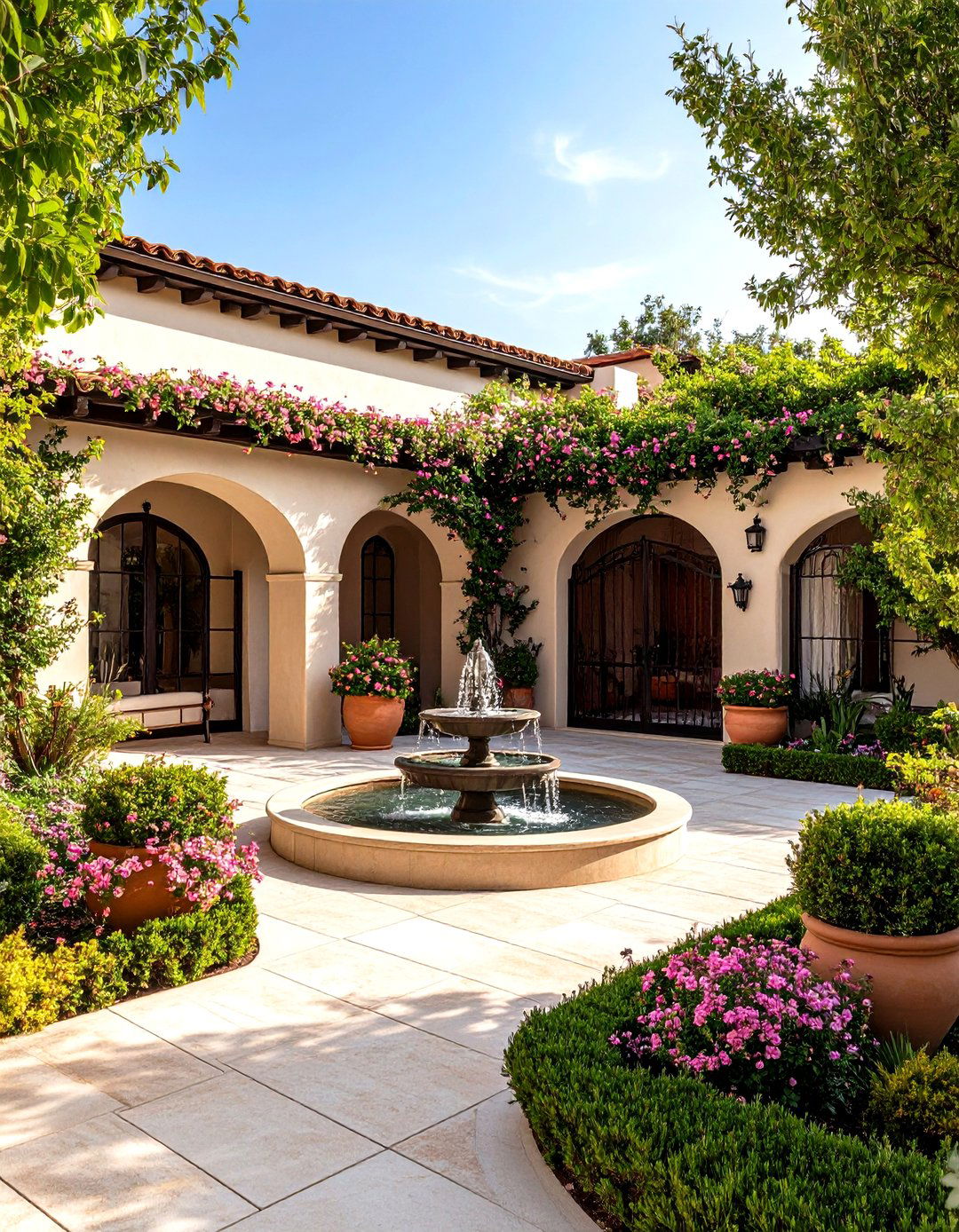

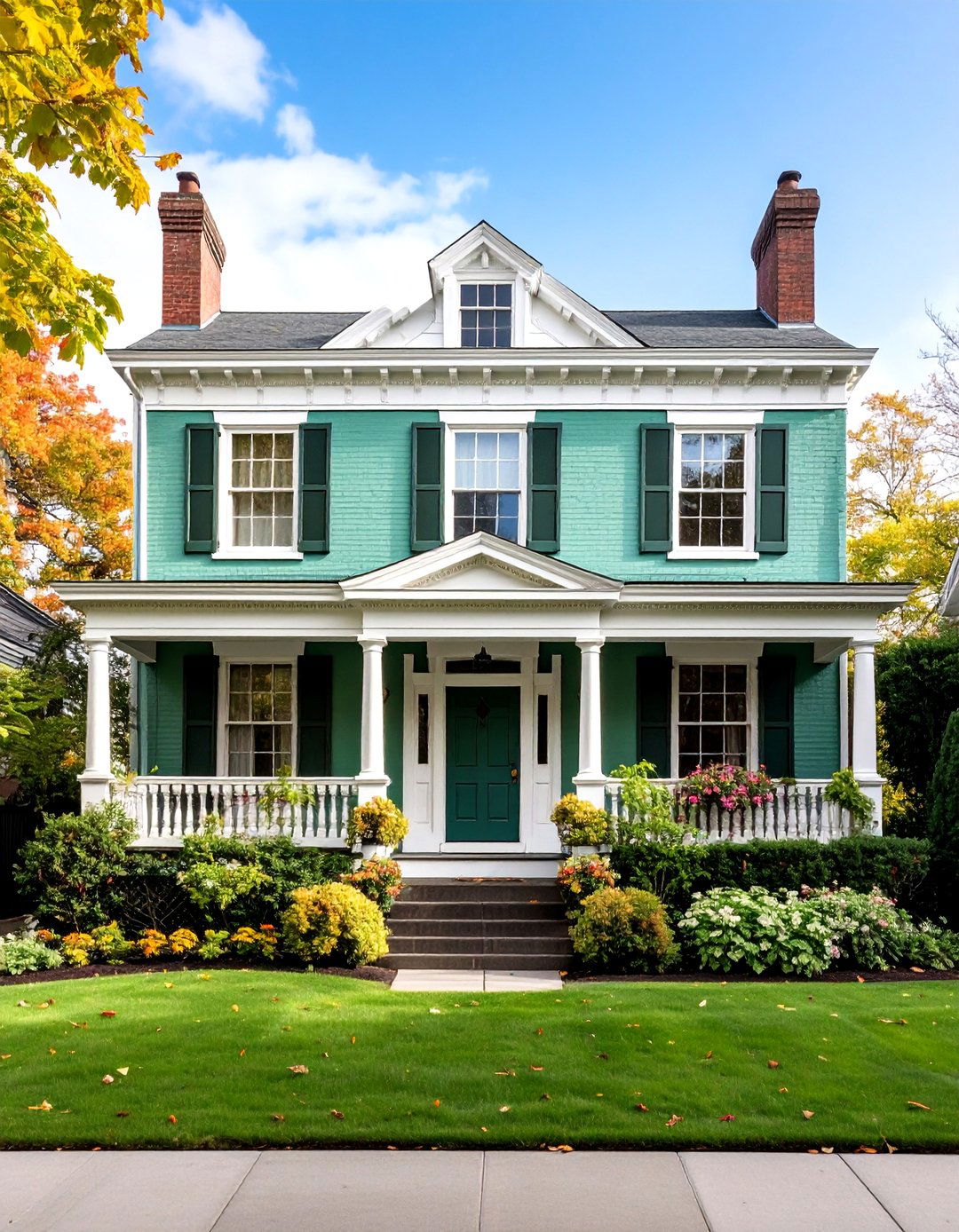
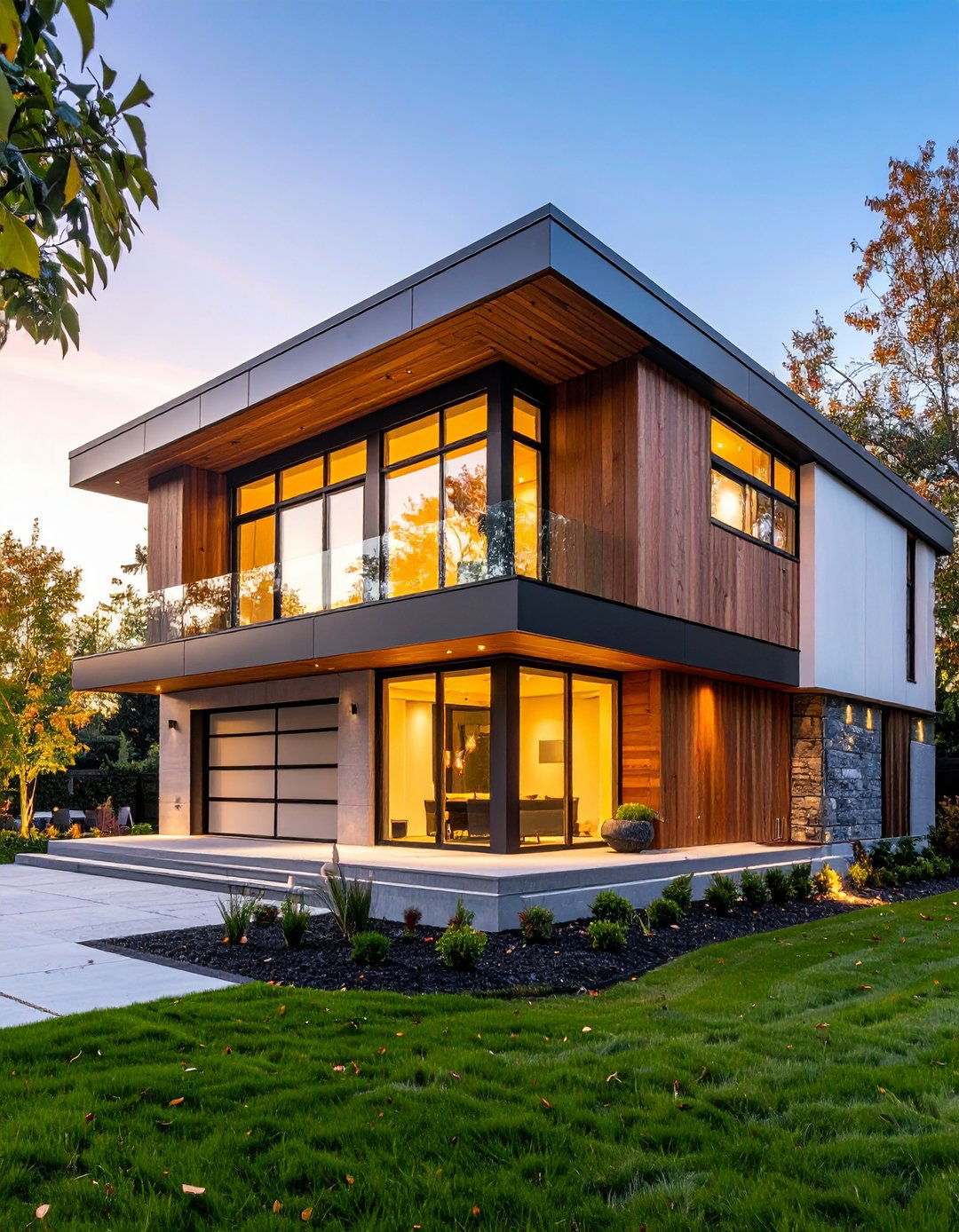
Leave a Reply